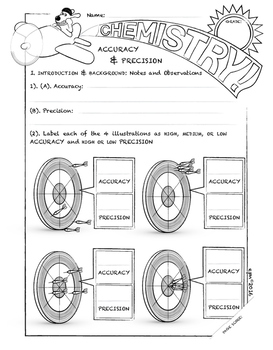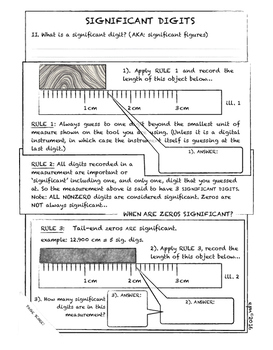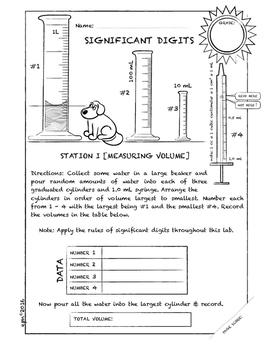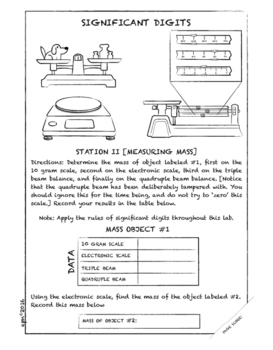ACCURACY & PRECISION LAB: (Significant Digits, aka: Significant Figures)
eyeLEARN
642 Followers
Grade Levels
7th - 12th, Higher Education, Adult Education, Homeschool
Subjects
Resource Type
Formats Included
- PDF
Pages
13 pages
eyeLEARN
642 Followers
What educators are saying
My students were engaged during the 2 class periods we worked on and I loved listening to their conversations as the worked. An answer key would have been nice to have.
This resource allowed students to learn and understand the difference between accuracy and precision. This can be a hard concept to grasp as the words are often used interchangeably in the English language. This resource allowed students to come to terms with the different meanings at their own pace
Description
ACCURACY & PRECISION LAB: (Significant Digits, aka: Significant Figures)
There would seem to be nothing, that strikes more fear into the hearts of young science students more than the mention of significant digits, aka significant figures. I think that’s in part due to the fact that students don’t see the practical application of these internationally accepted rules for recording the accuracy and precision of data and results. Here, I think, is a great lab to help students understand how and why we need this system. It is an updated version of an activity that I have done for many years with great success. I hope you find it valuable as well.
(This lab includes a preview activity on accuracy and precision, described below, and the lab activity itself. As always, this lab is adorned with the pictures that I know my students and now, thankfully, many of yours have come to expect - and I happy to share.)
Lesson Description: I generally do this activity after my young whippersnappers have completed one or two labs already, (the density lab is a good one – see the description under the product list). They will have already begun to struggle with how to read a volume from a graduated cylinder, and ask questions like, “How do I round my calculator answer?” The first part of this activity is essentially a worksheet that I generally do with the kids together. (In my case, I project the actual worksheet questions up on the board and discuss the rules and answer the questions together.
After we have completed the group worksheet, usually on the second day, students go to the lab and complete the second part of the lab which is the ‘hands-on’ part. [By the way, if you’re looking for some online video tutorials on this topic and many others, please visit our website at: http://eyelearn.wixsite.com/eyelearn To go directly to an eyeLEARN video tutorial on Accuracy and Precision go to, https://www.youtube.com/watch?v=TJHPpBiX3CQ ].
There are 4 stations in this lab activity, I). Measuring Volume, II). Measuring Mass, III). Measuring Temperature, and IV). Measuring Length. What you need for each lab station is listed in the lab itself. However, feel free to change it up to match the type of equipment you have in your classroom. Split your class into 4 groups and have them go to any one of the four stations, order does not matter. Get them about 15 to 20 minutes to complete each station and then rotate. The lab usually takes about one to one and a half hours.
ACCURACY & PRECISION LAB: (Significant Digits, aka: Significant Figures)
Chemistry, Physical Sciences, and; College-Level Classes: What you get…
~ 13 pages
Activity cover sheet(s)
Background and instructions (see above also)
Prelab activity described above
Data sheets
Results and conclusion questions
Practice and review questions all with illustrations
Optional Competency Grading
This unit activity meets or exceeds 21st Century and STEM learning expectations, and Common Core learning outcomes. Note: although eyeLEARN activities fulfill multiple CCSS, specific CCS standards are not listed because most activities are designed to be used over many graded levels so the specific CCSS may be different depending upon these factors. For a list of CCSS in your state please visit- www.corestandards.org
New – Integrated Holistic QPA, (that’s Quality Performance Assessment) created by me! This activity requires NO RUBRICS! The rubric is integrated into the activity itself. Much less work for you and far more meaningful to your students.
Working to change STEM to STEAM.
There would seem to be nothing, that strikes more fear into the hearts of young science students more than the mention of significant digits, aka significant figures. I think that’s in part due to the fact that students don’t see the practical application of these internationally accepted rules for recording the accuracy and precision of data and results. Here, I think, is a great lab to help students understand how and why we need this system. It is an updated version of an activity that I have done for many years with great success. I hope you find it valuable as well.
(This lab includes a preview activity on accuracy and precision, described below, and the lab activity itself. As always, this lab is adorned with the pictures that I know my students and now, thankfully, many of yours have come to expect - and I happy to share.)
Lesson Description: I generally do this activity after my young whippersnappers have completed one or two labs already, (the density lab is a good one – see the description under the product list). They will have already begun to struggle with how to read a volume from a graduated cylinder, and ask questions like, “How do I round my calculator answer?” The first part of this activity is essentially a worksheet that I generally do with the kids together. (In my case, I project the actual worksheet questions up on the board and discuss the rules and answer the questions together.
After we have completed the group worksheet, usually on the second day, students go to the lab and complete the second part of the lab which is the ‘hands-on’ part. [By the way, if you’re looking for some online video tutorials on this topic and many others, please visit our website at: http://eyelearn.wixsite.com/eyelearn To go directly to an eyeLEARN video tutorial on Accuracy and Precision go to, https://www.youtube.com/watch?v=TJHPpBiX3CQ ].
There are 4 stations in this lab activity, I). Measuring Volume, II). Measuring Mass, III). Measuring Temperature, and IV). Measuring Length. What you need for each lab station is listed in the lab itself. However, feel free to change it up to match the type of equipment you have in your classroom. Split your class into 4 groups and have them go to any one of the four stations, order does not matter. Get them about 15 to 20 minutes to complete each station and then rotate. The lab usually takes about one to one and a half hours.
ACCURACY & PRECISION LAB: (Significant Digits, aka: Significant Figures)
Chemistry, Physical Sciences, and; College-Level Classes: What you get…
~ 13 pages
Activity cover sheet(s)
Background and instructions (see above also)
Prelab activity described above
Data sheets
Results and conclusion questions
Practice and review questions all with illustrations
Optional Competency Grading
This unit activity meets or exceeds 21st Century and STEM learning expectations, and Common Core learning outcomes. Note: although eyeLEARN activities fulfill multiple CCSS, specific CCS standards are not listed because most activities are designed to be used over many graded levels so the specific CCSS may be different depending upon these factors. For a list of CCSS in your state please visit- www.corestandards.org
New – Integrated Holistic QPA, (that’s Quality Performance Assessment) created by me! This activity requires NO RUBRICS! The rubric is integrated into the activity itself. Much less work for you and far more meaningful to your students.
Working to change STEM to STEAM.
Total Pages
13 pages
Answer Key
N/A
Teaching Duration
N/A
Report this resource to TPT
Reported resources will be reviewed by our team. Report this resource to let us know if this resource violates TPT’s content guidelines.





